From the BBC: Apollo 11 Moon Landing: Everything You Need to Know

Apollo 11 Moon landing: Everything you need to know
It’s 55 years since US astronauts Buzz Aldrin and Neil Armstrong became the first people to walk on the Moon.
Neil Armstrong stepped onto the surface of the Moon on 20 July 1969. As he did so, he spoke the famous words: “That’s one small step for man, one giant leap for mankind.”
A camera was able to transmit the moment to around 650 million people who were watching the Apollo mission on television.
Armstrong was closely followed by fellow astronaut Buzz Aldrin, who described the Moon as “magnificent desolation”.
They spent 21 hours on its surface, including a seven-hour sleep, before returning to Earth.
Find out more about the Apollo 11 mission below.
Why was the Apollo 11 Moon landing so important?
The simple reason is that it had never been done before – and it was a big ambition for countries, and their space programmes, to be the first to land a human on the Moon’s surface.
In the run-up to the Moon landing, the US was competing with the Soviet Union in something called the space race. This was a competition to be the first to complete missions exploring the world outside the Earth’s atmosphere.
This race started when the Soviets – the US’s enemy during the Cold War – launched the first Soviet Sputnik satellite in 1957.
Then, Soviet cosmonaut Yuri Gagarin became the first human in space on 12 April 1961.
The Americans wanted technological superiority – and it looked like the Soviets were winning in the space race.
So, in 1962, US President John F Kennedy announced a big ambition, in a speech which is now very famous.
“We choose to go to the Moon!” he said.
US space agency Nasa invested lots of money (around $25 billion, which is around £20 billion) and effort into making this happen. The mission would come to be known as the Apollo programme and its goal was to land humans on the Moon and bring them safely back to Earth.
About 400,000 people worked on it.
-
About 400,000 people worked on the Apollo 11 mission
-
It cost Nasa around £25 billion (£20 billion)
-
The mission blasted off on 16 July 1969
-
It took four days, six hours and 45 minutes to get to the Moon
-
The lunar module landed on the Moon at 8:17pm on 20 July 1969
-
By the time the crew landed back on Earth, the mission had taken 8 days, 3 hours, 18 minutes and 35 seconds
-
A total of 12 people have walked on the Moon
-
The last people walked on the Moon in 1972
How did Apollo 11 astronauts get to the Moon?
The Moon is about 240,000 miles from Earth – so the Apollo mission was not going to be an easy task. It was also a dangerous mission.
The Apollo mission that would eventually land a man on the Moon – Apollo 11 – was not the first.
Apollo 8 and 10 entered lunar orbit but didn’t achieve the program’s goal, while during Apollo 1, the crew of three tragically died in a launch pad fire.
On the morning of 16 July 1969, astronauts Buzz Aldrin, Neil Armstrong and Michael Collins blasted off aboard a Saturn 5 rocket, which propelled them out of Earth’s gravity.

This picture shows the Saturn 5 rocket launching
The Apollo 11 mission had three spacecraft: the Command Module Columbia, a Service Module and the Lunar Module Eagle.
It took four days, six hours and 45 minutes to get to the Moon.
The lunar module landed on the Moon at 8:17pm on 20 July 1969.